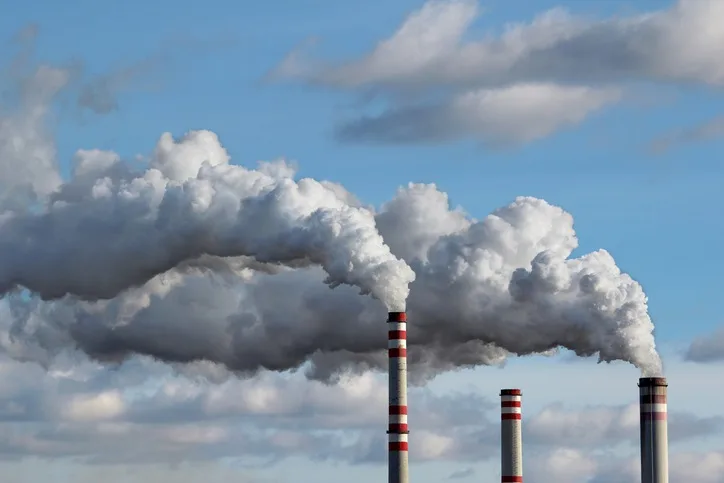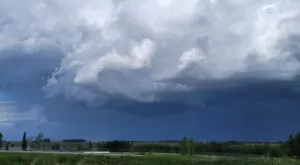
The world is way off track to limit climate change, say UN and WMO
The current trajectory we are on will most certainly push global temperatures past the goals of the 2015 Paris Agreement.
Just days before world leaders meet in Glasgow for COP26, a new report has revealed just how far off course we are to achieving the goals of the Paris Agreement and limiting the impacts of global warming.
"The Greenhouse Gas Bulletin contains a stark, scientific message for climate change negotiators at COP26. At the current rate of increase in greenhouse gas concentrations, we will see a temperature increase by the end of this century far in excess of the Paris Agreement targets of 1.5 to 2 degrees Celsius above pre-industrial levels," Professor Petteri Taalas, the Secretary-General of the World Meteorological Organization, said in a WMO press release this past week.
In fact, Taalas said, "We are way off track."
According to the report, the concentration of carbon dioxide in the atmosphere exceeded 413 parts per million (ppm) in 2020. That’s a nearly 50 per cent increase in the abundance of CO2 over how much was in the atmosphere in pre-industrial times.
Although it was reported that CO2 reached 417 ppm in 2020, and then 420 ppm for the first time earlier this year, those values came from just one site — atop Mauna Loa in Hawaii — and they represented the maximum concentrations recorded at the peak of the yearly cycle.
In contrast, the 413.2 ppm concentration reported in the WMO's Greenhouse Gas Bulletin is an annual average tallied from measurements recorded by nearly 140 sites around the world.
As the graph below shows, carbon dioxide concentrations follow a 'saw-tooth' pattern over a year. The pattern closely follows the seasons of the northern hemisphere, due to there being more land mass, and thus more plant growth and more industrial activity. As a result, daily and monthly concentrations peak in April or May, and reach their lowest point in September or October.

Global annual average carbon dioxide concentrations from the WMO's Global Atmosphere Watch Programme, from 1984 to 2020. Credit: WMO
As emissions have increased, though, both the maximum and minimum concentrations of CO2 are pushed higher, and the average concentration (the red line in the graph) increases along with them.
"The amount of CO2 in the atmosphere breached the milestone of 400 parts per million in 2015. And just five years later, it exceeded 413 ppm," said Taalas. "This is more than just a chemical formula and figures on a graph. It has major negative repercussions for our daily lives and well-being, for the state of our planet and for the future of our children and grandchildren."
"Carbon dioxide remains in the atmosphere for centuries and in the ocean for even longer," Taalas added. "The last time the Earth experienced a comparable concentration of CO2 was 3–5 million years ago, when the temperature was 2–3°C warmer and sea level was 10–20 meters higher than now."
Along with the increase in carbon dioxide, the concentrations of methane and nitrous oxide — the next two most important greenhouse gases — also rose. Methane increased by another 11 parts per billion (ppb), reaching a global average of 1,889 ppb (a 263 per cent rise over pre-industrial levels). Nitrous oxide rose 1.2 ppb to reach an annual average of 333.2 ppb — a 123 per cent increase over pre-industrial levels.
Overall, CO2 is responsible for around 66 per cent of the warming the world is experiencing, with methane accounting for another 16 per cent, and nitrous oxide accounting for around 7 per cent.
MITIGATION STRATEGIES FALLING SHORT
From October 31 to November 12, the leaders of the world will be gathered in Glasgow, Scotland, for the 2021 United Nations Climate Change Conference (COP26). The primary purpose of the conference is to set down a definitive path for the nations of the world to cut greenhouse gas emissions to the point where we can limit global warming to just 1.5°C above pre-industrial temperatures.
COP26 is the time and place for nations to step up and present new plans and commitments that are even bolder than the ones they made in 2015.
However, according to the UN's latest Emissions Gap Report, "new national climate pledges combined with other mitigation measures put the world on track for a global temperature rise of 2.7°C by the end of the century."
The annual Emissions Gap Reports, released by the United Nations Environment Programme (UNEP), provide an estimate of how far we are from achieving the goals of the Paris Agreement. They look at where emission levels are expected to be in 2030, based on the actions and commitments of the world's nations, and compare that with what they need to be, for us to avoid the worst climate impacts.
According to the 2021 report, the most up-to-date commitments currently being offered will only shave 7.5 per cent off the emission levels predicted for 2030. In order to meet the 1.5°C goal of the Paris Agreement, the report says that emissions must be reduced by at least 55 per cent.
"Climate change is no longer a future problem. It is a now problem," Inger Andersen, Executive Director of the UN Environment Programme, said in a press release. "To stand a chance of limiting global warming to 1.5°C, we have eight years to almost halve greenhouse gas emissions: eight years to make the plans, put in place the policies, implement them and ultimately deliver the cuts. The clock is ticking loudly."
"NET-ZERO" COMMITMENTS ARE A RAY OF HOPE
According to the UN report, in addition to the Nationally Determined Contributions (NDCs) offered going into COP26, 49 countries from around the world, plus the European Union, have all submitted "net-zero emission" pledges.
By "net-zero", they mean that there may still be GHG emissions at that point, but technologies will be in place to either capture those emissions before they enter the environment or to remove excess greenhouse gases from the atmosphere to compensate. This may also include plans to plant trees and increase greenspace to improve the natural carbon sink, or a combination of these strategies to meet the final goal.
The overall goal of these net-zero plans is to ensure that greenhouse gas concentrations in the atmosphere and ocean are no longer increasing.
"If made robust and implemented fully, net-zero targets could shave an extra 0.5°C off global warming, bringing the predicted temperature rise down to 2.2°C," the UN press release stated. "However, many of the national climate plans delay action until after 2030, raising doubts over whether net-zero pledges can be delivered. Twelve G20 members have pledged a net-zero target, but they are still highly ambiguous. Action also needs to be frontloaded to make it in line with 2030 goals."
These pledges would certainly bring us closer to achieving the broader 2°C goal of the Paris Agreement. They are not enough — yet — to reach the more ambitious target of 1.5°C, which was included at the behest of island nations around the world which would be inundated by sea level rise if temperatures rose by 2°C above pre-industrial levels.
"As this report makes clear, if countries deliver on their 2030 NDCs and net-zero commitments which have been announced by the end of September, we will be heading towards average global temperature rises of just above 2°C. So there has been progress, but not enough," said Alok Sharma, the president of COP26. "That is why we especially need the biggest emitters, the G20 nations, to come forward with stronger commitments to 2030 if we are to keep 1.5°C in reach over this critical decade."
Thumbnail image courtesy Getty Images











